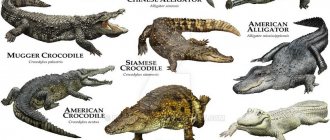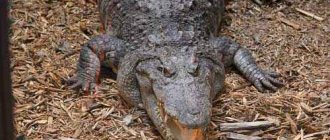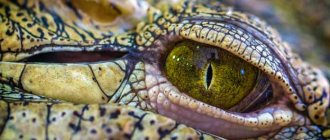Short answer about the difference between an alligator and a crocodile
The most obvious way to tell the two reptiles apart is by looking at their sinister-looking faces. Alligators have a U-shaped snout, wide and short, while crocodiles have a thin, almost V-shaped snout. When an alligator closes its mouth, you usually only see its upper teeth. On the other hand, crocodiles flash a toothy grin, intertwining their upper and lower teeth.
Not only that, but they also vary in location, habitat, size, color, speed and behavior. There may be other differences between them. But in this list you will find some of their distinctive qualities that will help you identify them.
Spine
The axial skeleton of the crocodile is represented by a very mobile and durable spine. It is this that allows the reptile to cope with fairly high loads when moving and fighting for survival. With the exception of some marine genera, all crocodiles have twenty-four presacral vertebrae, two sacral vertebrae, and thirty to forty caudal vertebrae. In modern reptiles, the first nine vertebrae are cervical. The ribs are simple rods with slightly expanded heads by which they are connected to the spine.
Today there are many manuals and textbooks on zoology with the name of crocodile skeletal bones, which are quite well studied.
Alligator vs Crocodile: Appearance
The most obvious difference between alligators and crocodiles is their appearance. They differ not only in the shape of the muzzle, but also in the size of the jaw and body. The difference in the shape of a crocodile's and an alligator's face simply signifies the power emanating from their mouths. This comes in handy when they dissect hard-shelled vertebrates, such as turtles.
Some differences between alligators, true crocodiles and caimans are visible to the naked eye.
How to spot an alligator
Alligators have a long, rounded snout with upward-facing nostrils at the end. This allows them to breathe while the rest of their body is underwater. They also have four short legs, with the front legs having five toes and the back legs only four toes.
Both sexes have an armored body with a muscular, flat tail. The skin on their back is also covered with bony plates called osteoderms. Young alligators have yellow stripes on their tails, while adults have dark stripes. It is also easy to distinguish the teeth of an alligator from a crocodile.
In alligators, their lower teeth are not visible when they close their mouths. Whereas crocodiles have a large fourth tooth in the lower jaw. In addition, adult alligators have 80 teeth in their mouths at any one time. By replacing teeth as they are lost, alligators can go through 3,000 teeth in their lifetime.
[CHOSEN FOR YOU] Interesting Facts About Wall Street, New York
Female alligators are smaller than males. The average size of an adult male alligator is 341 cm, and the average size of an adult female is 250 cm. Both sexes also do not reach extreme weights. An adult female weighs about 91 kilograms, and an adult male weighs up to 360 kilograms.
How to spot a crocodile
Crocodiles have long, pointed, V-shaped snouts compared to alligators. It is also not that difficult to distinguish an alligator from a crocodile from a distance. You only need to look at the shape of their muzzle and the visibility of their teeth. Crocodiles create a toothy grin by closing their mouths due to the equal size of their upper and lower jaws.
They also have powerful jaws with many teeth. Crocodiles have large, broad bodies, short legs, clawed, webbed toes, and a muscular tail. Additionally, their eyes, ears and nostrils are located on the top of their head. This allows them to see even if they submerge their body in water while hunting. Crocodiles' tails are long and massive, and their skin is thick and plated, like that of alligators.
On the one hand, large male crocodiles can reach 579 cm in length and weigh up to 1000 kg. On the other hand, large female crocodiles grow up to 335 cm and can weigh around 200 kg. The largest recorded crocodiles are saltwater crocodiles. Next on the list will be Nile crocodiles weighing up to 750 kilograms. And the last ones will be American crocodiles weighing at least 750 kilograms.
Description
The skeletal structure of a crocodile is very similar to that of a lizard. The skeleton of the animal consists of a skull, five sections of the spine and bones of the limbs. The way the animal’s body is structured speaks about the historical method of adaptation to life in water. Elongated and flattened body. Long, flexible tail. Short paws located on both sides of the body. Membranes that connect the fingers of crocodiles to each other.
The skeleton of a crocodile is represented by the following components:
- Skull bones. Lower and upper jaws with teeth.
- Cervical, thoracic, lumbar, sacral, caudal sections.
- Femur.
- Leg bones: tibia and fibula.
- Forelimb: ankle and metatarsus (the bone that forms the part of the foot between the ankle and toes).
- Phalanx: Each of the small bones that form the fingers.
- Shoulder.
- Spatula.
- Bones of the forearm.
- Rib: Each of the bones that form the rib cage.
This photo of a crocodile skeleton clearly shows the sacral vertebrae and their articulation with the femurs on one side and the sacral bones on the other.
You might be interested in:What is trash: the answer is hidden in history
The perfection of the musculoskeletal, nervous, circulatory and respiratory systems allows us to consider these animals the most highly organized of all living reptiles.
Alligator vs crocodile: behavior and habits
They say crocodiles are more aggressive than alligators. Alligators only attack when provoked. However, crocodiles attack because something or someone is close to them. These predators are both diurnal and nocturnal. This means that they are active both at night and during the day. Both are also excellent night hunters. They have vertical pupils that open wide in low light and allow them to see their prey.
[CHOSEN FOR YOU] The most unusual, exotic birds of the world
Both also spend most of their time in the water. But alligators also love to spend time in the sun. At their speed, alligators run on land up to 32 kilometers per hour. As for Nile crocodiles, their speed also reaches up to 35 kilometers per hour. Even when submerged in water, they can hold their breath for up to one hour.
Life of a Predator
The main part of life is spent in bodies of water, where the animal is cool and comfortable to catch food. To lay eggs, animals come to land.
Crocodiles are cold-blooded animals. A special layer under the shell always maintains the same temperature. During drought, animals hibernate.
You can tell what crocodiles eat, because their stomach is very strong. More experienced crocodiles can even afford to feast on a leopard that has come to a pond to drink.
Alligator vs Crocodile: Habitat
Crocodiles and alligators exist in both fresh and sea water. Alligators prefer fresh water. They live in rivers, swamps and lakes. They do not have salt glands, so they cannot tolerate salt water for long. Although crocodiles also live near rivers, lakes and swamps, they can also go to sea.
They are found in Southeast Asia, northern Australia and eastern India. American alligators thrive in Florida and Louisiana, southeast of the United States. They are also found in southern parts of Alabama, Mississippi and Georgia.
Both semi-aquatic predators have impressive lifespans. Alligators can live up to 50 years, while crocodiles can live up to 70 years. However, some claim more than 100 years. A male crocodile lived approximately 110 to 115 years in a Russian zoo in Yekaterinburg.
The oldest known living alligator is Muja. This is an American alligator that is over 83 years old. No one knows exactly when Muja was born, but it is said that it was sometime before 1937. It is located in the Belgrade Zoo in Serbia.
Lifestyle
The lifestyle of crocodiles occurs mainly in fresh waters, since they are semi-aquatic animals, but they lay eggs on land. The reptile comes ashore during daylight hours - in the morning or evening.
The body temperature of a crocodile fluctuates during the day by 1-2 C. In intense heat, crocodiles open their mouths to evaporate moisture, and in drought they can bury themselves in the mud at the bottom of a drying reservoir.
They usually live near water, but in extreme cases they can travel long distances at speeds of 17 km/h.
Alligator vs Crocodile: Diet
Crocodiles and alligators are carnivores, which means they only eat meat. Their diet consists of fish, frogs, birds and even turtles. Zoo crocodiles eat animals that have already been killed for them, such as mice, fish or rats. In the wild, crocodiles and alligators ambush their prey and drag it into the water until they drown. The bite force of crocodiles is 351 kgf/cm², and that of alligators is 208 kgf/cm².
Both will crush their prey with their massive jaws and swallow it whole. These predators cannot chew their prey into small pieces like other animals. Although alligators only eat meat, some say they also eat fruit.
[CHOSEN FOR YOU] The most unusual and expensive breeds of chickens
There are reports of crocodiles preying on people. Two well-known species have this reputation: Nile crocodiles and saltwater crocodiles. Hundreds of fatal attacks attributed to the Nile crocodile have occurred in sub-Saharan Africa. While attacks by saltwater crocodiles usually occur in Southeast Asia and Australia.
Alligators have also been reported to attack people. There have been reports of these reptiles attacking small children and the elderly. Despite these reports, alligators rarely prey on humans compared to crocodiles.
Exoskeleton
The "external skeleton" of crocodiles consists of a network of interconnected scales or scutes of various shapes and sizes. On the ventral surface they tend to be square and flat. On the sides and on the neck - round, with a raised center. Along the posterior and upper surfaces of the tail, the scales are raised very clearly.
The bony formations are part of the crocodile's skeleton, which consists of discrete and isolated blocks called "osteoderms". Their relief is most pronounced along the back. Provided with a rich blood supply. The extent to which they are deposited in the ventral part of the body varies between species and within a species from different subspecies.
The bony scales along the back are "armor". Some species are considered more heavily armored than others. This difference greatly affects the ability to protect delicate internal organs from injury during fights with other crocodiles. Therefore, teeth marks on them are a fairly common occurrence.
The vertical scales along the tail (scutes) are hardened. They significantly increase the surface area of the tail and play a role in swimming efficiency. They have good blood supply. They are places of heat exchange between the animal and the environment.
Relationship between alligators and crocodiles
Alligators come from the family Alligatoridae, and crocodiles from the family True crocodiles. Alligators and crocodiles are similar in appearance, but cannot mate. Both types are too different. But these predators mate almost the same way. Crocodiles and alligators mate by first making sounds, flapping their heads, and wrestling for hours. Like other animals, alligators also use scent by secreting scent from their musk glands.
Crocodiles and alligators mate underwater. The mating process usually lasts several minutes. But a couple may mate several times a season to ensure fertilization. Female crocodiles and alligators usually lay eggs four to six weeks after mating. Mothers lay about 60 eggs in a nest they make and cover them before returning to the water. The eggs hatch in about 3 months.
The sex of the young depends on the temperature inside the nest. If the temperature is between 32 and 33 degrees Celsius, the hatchlings will be males . But, if the temperature is below 32 degrees Celsius, female babies will hatch . Both male crocodiles and alligators mate with as many females as possible. Despite this, monogamous pairs of American alligators suggest otherwise.
Now that you know the difference, you can tell the difference between alligators and crocodiles. There may be differences between them, but both are amazing animals. If you want to see both creatures in the wild, South Florida is the only place where you can find them coexisting.
Reproduction
Puberty in crocodiles occurs at 8-10 years of age. The breeding season for different species of crocodiles occurs at different times of the year. The southern ones lay eggs in winter, the northern ones in autumn.
During the mating season, the male calls the female with a characteristic roar. During mating games, they rub their muzzles. Females make nests on sandbanks near a pond. The nest reaches a depth of 1.5, where 20-85 eggs are laid.
The incubation period is 3 months. Although crocodiles carefully protect their offspring, only 10% of crocodiles hatch. After birth, the cubs emit a characteristic squeak and the mother carries them to the water.
The mother takes care of the cubs until they are 2 years old, after which the crocodiles move into adulthood. Their sizes reach 1-1.5 m, and they can take care of themselves independently.











